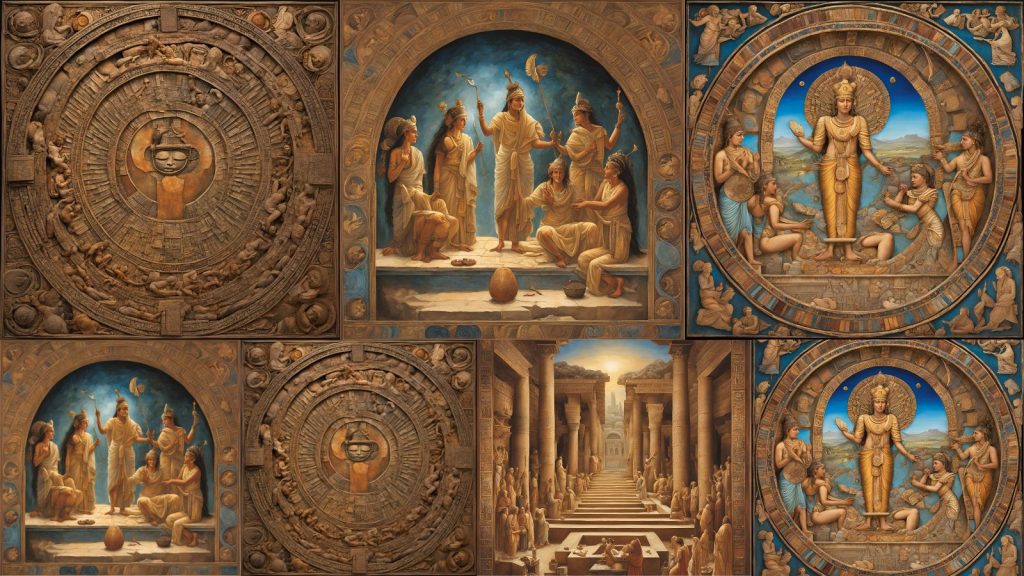Ancient artz refers to the artistic creations of civilizations that flourished thousands of years ago, offering us a window into the values, spirituality, and lifestyles of their creators. From the monumental pyramids of Egypt to the delicate pottery of the Greeks, ancient artz demonstrates an extraordinary level of craftsmanship, ingenuity, and cultural significance. This article explores the origins, diversity, and significance of ancient artz, along with the various forms it took across different civilizations.
The Origins of Ancient Artz
Ancient art dates back approximately 40,000 years, originating in the Paleolithic era when early humans first began making visual representations. One of the earliest known examples of human creativity is found in the Chauvet-Pont-d’Arc Cave in France, where ancient people used charcoal and ochre to create drawings of animals and abstract forms. These early artworks likely had spiritual or ritual significance, connecting early human communities to their environment and beliefs.
As human civilization evolved, so did the art forms, expanding across continents and adapting to different cultures. Ancient artz includes a wide range of artistic expressions, from religious icons to everyday objects. Each civilization added its interpretations, materials, and techniques, making ancient art a reflection of the diversity and creativity of the human spirit.
Key Forms of Ancient Artz
Ancient artz encompasses various artistic forms, each serving different purposes, whether for spiritual, functional, or decorative reasons. The most prominent forms include:
1. Sculptures and Statues
Sculpture was one of the earliest and most enduring forms of ancient art. Civilizations such as Ancient Egypt, Greece, and Mesopotamia created large statues of gods, rulers, and mythological figures. These statues were often made from stone, bronze, or marble and were used to convey power, religious beliefs, and cultural values.
For example, the Egyptian pyramids are not only architectural marvels but also serve as monumental sculptures, embodying the pharaohs’ journey to the afterlife. Greek statues, like the iconic “Venus de Milo,” celebrated human beauty and form, showcasing the advanced understanding of anatomy and proportion.
2. Murals and Frescoes
Murals and frescoes are another important form of ancient art. These paintings were often created on the walls of temples, tombs, and palaces, offering a glimpse into the daily life, religious rituals, and beliefs of ancient civilizations. Ancient Egyptians, Romans, and Mesoamerican cultures are particularly known for their vibrant and intricate wall paintings.
The frescoes in the Palace of Knossos on the island of Crete, for instance, depict scenes of bull-leaping and other ceremonial activities, providing valuable insights into the culture and rituals of the Minoans.
3. Pottery and Ceramics
Pottery and ceramics are among the most widely found artifacts from ancient civilizations. These items were not only practical but also served as a medium for artistic expression. The ancient Greeks, Romans, and Chinese, among others, created beautifully crafted pottery, often decorated with intricate patterns, scenes from mythology, or daily life.
Greek pottery, for example, is renowned for its black-figure and red-figure techniques, which allowed artists to create detailed depictions of gods, heroes, and everyday scenes.
4. Jewelry and Metalwork
Jewelry and metalwork were essential components of ancient artz, often signifying wealth, status, or religious devotion. Ancient cultures like the Egyptians, Mesopotamians, and Romans crafted exquisite jewelry from gold, silver, and precious stones, using advanced techniques such as casting, engraving, and filigree.
The famous Egyptian burial mask of King Tutankhamun is a prime example of the intricate craftsmanship in ancient jewelry, with its gold and lapis lazuli inlays representing the king’s divine status.
5. Architectural Marvels
Architecture is another key aspect of ancient artz. The grandeur and precision of ancient architectural structures, such as the Pyramids of Giza, the Parthenon in Athens, and the Colosseum in Rome, demonstrate the advanced engineering and artistic abilities of these civilizations. These structures were often built for religious, political, or social purposes, and their design and scale were meant to convey power, divine favor, and cultural identity.
The ancient Romans, for example, mastered the use of arches and concrete, allowing them to build large, durable structures like the Colosseum, which still stands as a testament to their architectural ingenuity.
The Timeless Appeal of Ancient Artz
What sets ancient artz apart is its timeless appeal. These artworks have transcended time, preserving the essence of their era while continuing to inspire modern artists, scholars, and enthusiasts. Each piece tells a unique story, whether it’s the spiritual significance of a statue, the historical context of a mural, or the craftsmanship behind a piece of pottery.
Ancient artz also serves as a reflection of human civilization’s evolution, from early symbolic representations to the grand artistic achievements of the classical world. These works provide invaluable insights into the beliefs, practices, and daily lives of ancient peoples, helping us understand their cultures and how they viewed the world around them.
FAQs About Ancient Artz
1. What is the significance of ancient art?
Ancient art is significant because it provides a window into the values, beliefs, and lifestyles of ancient civilizations. It reflects the spiritual, cultural, and social aspects of the societies that created it, offering insights into their religious practices, daily activities, and political structures. Ancient art also demonstrates the technical skills and creativity of the artists who produced it, showcasing their craftsmanship and ingenuity.
2. What materials were used in ancient art?
Ancient artists used a wide variety of materials, including stone, clay, metal, wood, and organic pigments. For example, sculptures were often made from stone or bronze, while pottery was crafted from clay and decorated with pigments. Paintings and frescoes were created using natural pigments like ochre, charcoal, and mineral-based colors. Jewelry and metalwork were made from precious metals like gold, silver, and copper, often inlaid with gemstones.
3. How did ancient art reflect spirituality and religion?
Ancient art often had a strong connection to spirituality and religion. Many sculptures, murals, and temples were created to honor gods, deities, or rulers who were believed to have divine power. For instance, Egyptian statues of pharaohs were often depicted as god-like figures, while Greek and Roman art frequently featured gods and mythological scenes. Art was also used in religious rituals, such as the creation of sacred objects or the decoration of temples.
4. What is the role of architecture in ancient art?
Architecture is a crucial form of ancient art that reflects the cultural and religious values of ancient societies. Large structures like temples, pyramids, and palaces were often designed to honor gods, rulers, or significant events. The scale and precision of these buildings demonstrated the technical abilities of the civilizations that constructed them. Ancient architecture also served as a form of artistic expression, with intricate carvings, sculptures, and frescoes adorning these monumental structures.
5. How has ancient art influenced modern art?
Ancient art has had a profound influence on modern art, inspiring artists throughout history. The techniques, themes, and forms used by ancient artists continue to shape contemporary art, whether in the use of classical proportions, the depiction of the human form, or the exploration of symbolism and spirituality. Modern artists often draw inspiration from ancient art, reinterpreting it in new contexts and mediums.
Conclusion
Ancient artz offers a rich and diverse array of artistic expressions that reflect the creativity, spirituality, and cultural values of ancient civilizations. From sculptures and pottery to murals and architecture, ancient art continues to inspire and inform our understanding of the past. By preserving these masterpieces, we gain valuable insights into the lives of those who created them, and we are reminded of the enduring power of art to transcend time and connect us to our shared human history.

